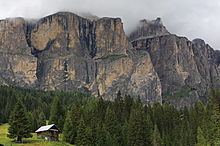Location Northeast Italy | ||
 | ||
San Cassiano Formation (Anisian-Carnian) is a geologic formation located on the Southern Alps (Northeast of Italy) in the Dolomites. These Triassic dolomites are considered to be a classic example of ancient carbonate platforms. As the allochthonous elements in the Shale strata (Cipit boulders) show a good preservation, fossils and microbialites contained in these elements are useful in detailed geochemical analyses.
Contents
History
Research on the San Cassiano Formation started in the 19th century with the works of Nicolas de Saussure and the stratigraphic works of Leopold von Buch and Alexander von Humboldt. By the late 19th century Richthofen and von Mojsisovics had already acknowledge the reefal origin of these mountains.
Geological background
The landscape of the Dolomites is dominated by Triassic carbonates, deposited from the Anisian to the Carnian. In the Lower Carnian (Julian) the percentages of carbonates increments due to the diminishing eustatic sea-level change. The last part of the reefal evolution is the development of patch reefs constituted by colonial corals (Scleractinia). Large areas of the reefs of the Dolomites suffered karstic erosian due to sea regression in the Anisian. A new transgression in the Carnian permitted new carbonate platforms to develop in swallow basins.
Stratigraphy
The San Cassiano Formation overlays the Wengen Formation (a volcanic flysch sequence); the limit between this two formations is arbitrary; usually considered as the first carbonate strata in the volcaniclastic sequence. The San Cassiano Formation shows a variable thickness from 300 m to 500 m; it was described by Ogilvie in 1893, and it is has two Members. The Inferior Member is constituted by an intercalated sequence of shale, limestone, volcaniclast (pseudoflysch) and marl; deposited from the Late Ladinian (Mid Triassic) to Early Carnian (Superior Triassic). The Superior Member is a sequence of pseudoflysch, marl, limestone and mudrock (in this strata some Cipit Boulders occur). This sequence was deposited from during the Middle Carnian.
The strata are very similar in both members; they are divided by biostratigraphic criteria based in the aon zone (Inferior Member) and aonoides and austracum zones (Superior Member). Dürrenstein Dolomite (a massive dolomite unit) overlies the San Cassiano Formation.
Paleoenvironment
In the 20th century the research in San Cassiano Formation was mostly focused in the study of facies analysis. The paleoenvironments represented in San Cassiano Formation are as follows: Reefal environments consisting of patch reefs; shallow marginal basin; carbonate platform; continental slope; and deep basin.
Facies
The facies identified in San Cassiano Formation:
These facies are interpreted as the next deposit environments:
Biota
The Patch reefs from Valle di Rimbianco present a diverse fauna of fossilized calcitic sponges (Porifera), corals (Cnidaria), bivalves and gastropods (Mollusca), Brachiopoda and Echinodermata. Large parts of the basin are not fossiliferous. In the deep basin and continental slope facies the fauna consists only on ammonites and pseudoplanktonic bivalves, beside of allochthonous elements eroded from the carbonate platform (Cipit Boulders).
Geochemistry
The facies that present less diagenetic alteration are the Cipit Boulders. The microbialites contained in these elements show a very good preservation and therefore are very useful as geochemical proxies to determine paleoenvironmental conditions of the carbonate platform. The carbonate platform itself suffered intense karstification and dolomitization, because of these alterations the fossils in this facies cannot be used in geochemical analysis.
